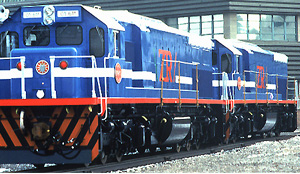 DESPITE recording some successes the Zambia Railways Limited (ZRL) has largely fallen on hard times recently and has been in the news usually painting a bleak picture to pessimists.
DESPITE recording some successes the Zambia Railways Limited (ZRL) has largely fallen on hard times recently and has been in the news usually painting a bleak picture to pessimists.
This is understandable bearing in mind that the railways at one time transported virtually all Zambia’s international trade up to the 1970s, though today only a few goods are transported by rail.
In recent years, the railway system has never been profitable and both railway lines TAZARA and Zambia Railways appear to be transporting a fraction of their former volumes.
This has been the sad trend for many years burdening the road transportation with goods that could traditionally be transported by rail.
With the recovery in copper production in recent years, and the congestion and damage to the roads caused by exporting copper by trucks, there have been general calls for investment in Zambia’s railways in order to reverse the switch from rail to road.
From time to time, the Government has announced ambitious plans to maintain, rehabilitate and upgrade the rail transport infrastructure despite the move being faced with several challenges.
There has been much lip service that both railway networks should be restored to their condition of the 1970s – and then extended (with new routes).
It is against this seemingly bleak background that we should hail ZRL’s plans to venture into fuel importation as a way of broadening its financial base.
Recently, chief executive officer Muyenga Atanga said ZRL had approached Government to give the company a percentage of the fuel consignment for the country.
Professor Atanga made the revelation of the good news with the assurance that Government had shown commitment to engage the railway company with the new task.
However, Professor Atanga said the only challenge that the company has is the fuel storage tanks that were unavailable at the moment as fuel required special storage facilities.
We share Prof Atanga’s optimism that there is hope that if ZR works with other companies, they could all benefit from each other and conquer their challenges.
We are also glad to hear that the company has now recovered from its imminent collapse and was headed for greatness to regain its old glory.
Needless to say the company has greatly improved the speed on its locomotives in the last two years as they now moved at 40 kilometers per hour for the passenger trains and 30 kilometers per hour for the cargo train.
Zambia Railways, which comprises more than 900 kilometers of mainline railways and 300 kilometers of branch line railway, is one of the largest rail networks within the region.
Zambians should not give up on our Zambia railway system which if properly put to good use can be revamped into a 21st-century railway system that is modern and profitable.
We hope the company will solve the problem of fuel storage tanks to ensure it operates smoothly in its new venture.
All in all, what ZR has done by diversifying into another venture needs massive support from all stakeholders for the hidden benefits that would be borne in the near future.
Diversification in business means reducing non-systematic risk by investing in a variety of assets.
For ZR, it is clear that the company is looking at benefits and not the hurdles that would hamper achievements of these benefits based on past challenges.
The railway system would roar again to offer an alternative to the exhausted road transportation that a poor railway network has burdened on the former. OPINION






